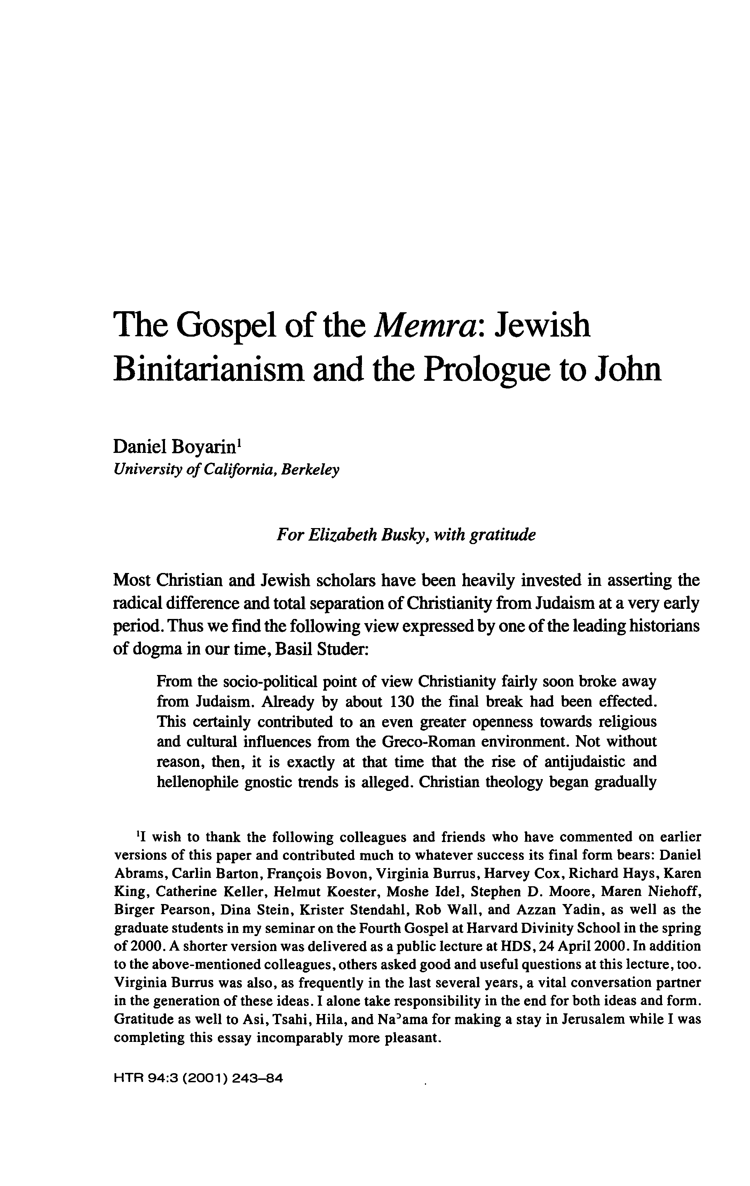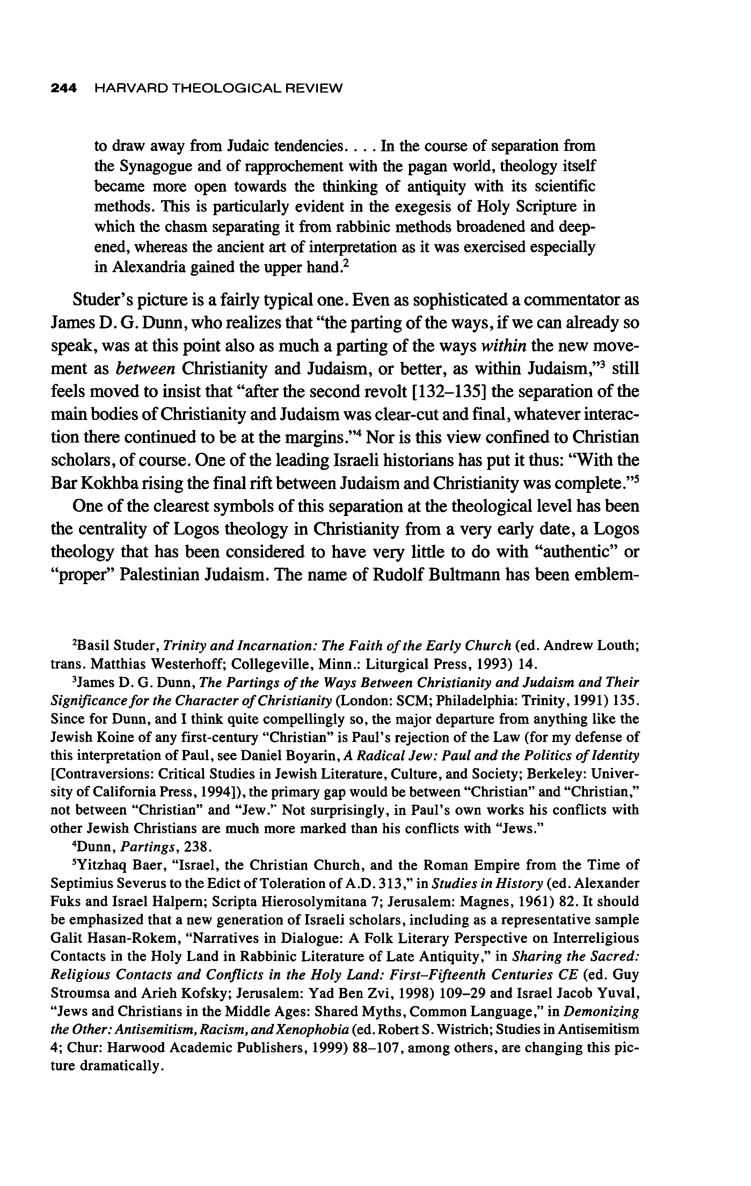
The Gospel of the Memra: Jewish
Binitarianism and the Prologue to John
Daniel Boyarín1
University of California, Berkeley
For Elizabeth Busky, with gratitude
Most Christian and Jewish scholars have been heavily invested in asserting the
radical difference and total separation of Christianity from Judaism at a very early
period. Thus we find the following view expressed by one of the leading historians
of dogma in our time, Basil Studer:
From the socio-political point of view Christianity fairly soon broke away
from Judaism. Already by about 130 the final break had been effected.
This certainly contributed to an even greater openness towards religious
and cultural influences from the Greco-Roman environment. Not without
reason, then, it is exactly at that time that the rise of antijudaistic and
hellenophile gnostic trends is alleged. Christian theology began gradually
!I wish to thank the following colleagues and friends who have commented on earlier
versions of this paper and contributed much to whatever success its final form bears: Daniel
Abrams, Carlin Barton, François Bovon, Virginia Burrus, Harvey Cox, Richard Hays, Karen
King, Catherine Keller, Helmut Koester, Moshe Idei, Stephen D. Moore, Maren Niehoff,
Birger Pearson, Dina Stein, Krister Stendahl, Rob Wall, and Azzan Yadin, as well as the
graduate students in my seminar on the Fourth Gospel at Harvard Divinity School in the spring
of 2000. A shorter version was delivered as a public lecture at HDS, 24 April 2000. In addition
to the above-mentioned colleagues, others asked good and useful questions at this lecture, too.
Virginia Burrus was also, as frequently in the last several years, a vital conversation partner
in the generation of these ideas. I alone take responsibility in the end for both ideas and form.
Gratitude as well to Asi, Tsahi, Hila, and NaDama for making a stay in Jerusalem while I was
completing this essay incomparably more pleasant.
HTR 94:3 (2001 ) 243-84

2 4 4 H A R V A R D T H E O L O G I C A L REVIEW
to draw away from Judaic tendencies. . . . In the course of separation from
the Synagogue and of rapprochement with the pagan world, theology itself
became more open towards the thinking of antiquity with its scientific
methods. This is particularly evident in the exegesis of Holy Scripture in
which the chasm separating it from rabbinic methods broadened and deep-
ened, whereas the ancient art of interpretation as it was exercised especially
in Alexandria gained the upper hand.2
Studer's picture is a fairly typical one. Even as sophisticated a commentator as
James D. G. Dunn, who realizes that "the parting of the ways, if we can already so
speak, was at this point also as much a parting of the ways within the new move-
ment as between Christianity and Judaism, or better, as within Judaism,"3 still
feels moved to insist that "after the second revolt [132-135] the separation of the
main bodies of Christianity and Judaism was clear-cut and final, whatever interac-
tion there continued to be at the margins."4 Nor is this view confined to Christian
scholars, of course. One of the leading Israeli historians has put it thus: "With the
Bar Kokhba rising the final rift between Judaism and Christianity was complete."5
One of the clearest symbols of this separation at the theological level has been
the centrality of Logos theology in Christianity from a very early date, a Logos
theology that has been considered to have very little to do with "authentic" or
"proper" Palestinian Judaism. The name of Rudolf Bultmann has been emblem-
2Basil Studer, Trinity and Incarnation: The Faith of the Early Church (ed. Andrew Louth;
trans. Matthias Westerhoff; Collegeville, Minn.: Liturgical Press, 1993) 14.
3James D. G. Dunn, The Partings of the Ways Between Christianity and Judaism and Their
Significance for the Character of Christianity (London: SCM; Philadelphia: Trinity, 1991) 135.
Since for Dunn, and I think quite compellingly so, the major departure from anything like the
Jewish Koine of any first-century "Christian" is Paul's rejection of the Law (for my defense of
this interpretation of Paul, see Daniel Boyarín, A Radical Jew: Paul and the Politics of Identity
[Contraversions: Critical Studies in Jewish Literature, Culture, and Society; Berkeley: Univer-
sity of California Press, 1994]), the primary gap would be between "Christian" and "Christian,"
not between "Christian" and "Jew." Not surprisingly, in Paul's own works his conflicts with
other Jewish Christians are much more marked than his conflicts with "Jews."
4Dunn, Partings, 238.
5Yitzhaq Baer, "Israel, the Christian Church, and the Roman Empire from the Time of
Septimius Severus to the Edict of Toleration of A.D. 313," in Studies in History (ed. Alexander Fuks and Israel Halpern; Scripta Hierosolymitana 7; Jerusalem: Magnes, 1961) 82. It should
be emphasized that a new generation of Israeli scholars, including as a representative sample
Galit Hasan-Rokem, "Narratives in Dialogue: A Folk Literary Perspective on Interreligious
Contacts in the Holy Land in Rabbinic Literature of Late Antiquity," in Sharing the Sacred:
Religious Contacts and Conflicts in the Holy Land: First-Fifteenth Centuries CE (ed. Guy
Stroumsa and Arieh Kofsky; Jerusalem: Yad Ben Zvi, 1998) 109-29 and Israel Jacob Yuval,
"Jews and Christians in the Middle Ages: Shared Myths, Common Language," in Demonizing
the Other: Antisemitism, Racism, and Xenophobia (ed. Robert S. Wistrich; Studies in Antisemitism
4; Chur: Harwood Academic Publishers, 1999) 88-107, among others, are changing this pic-





